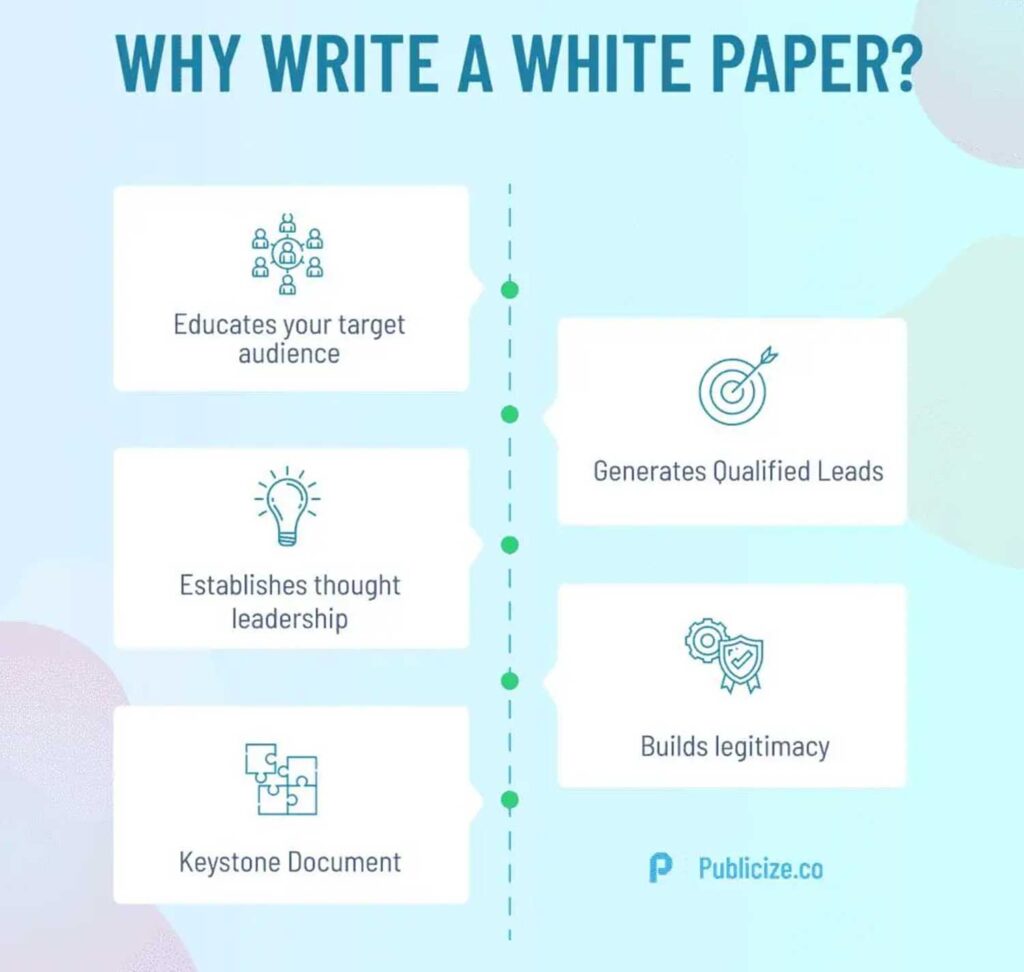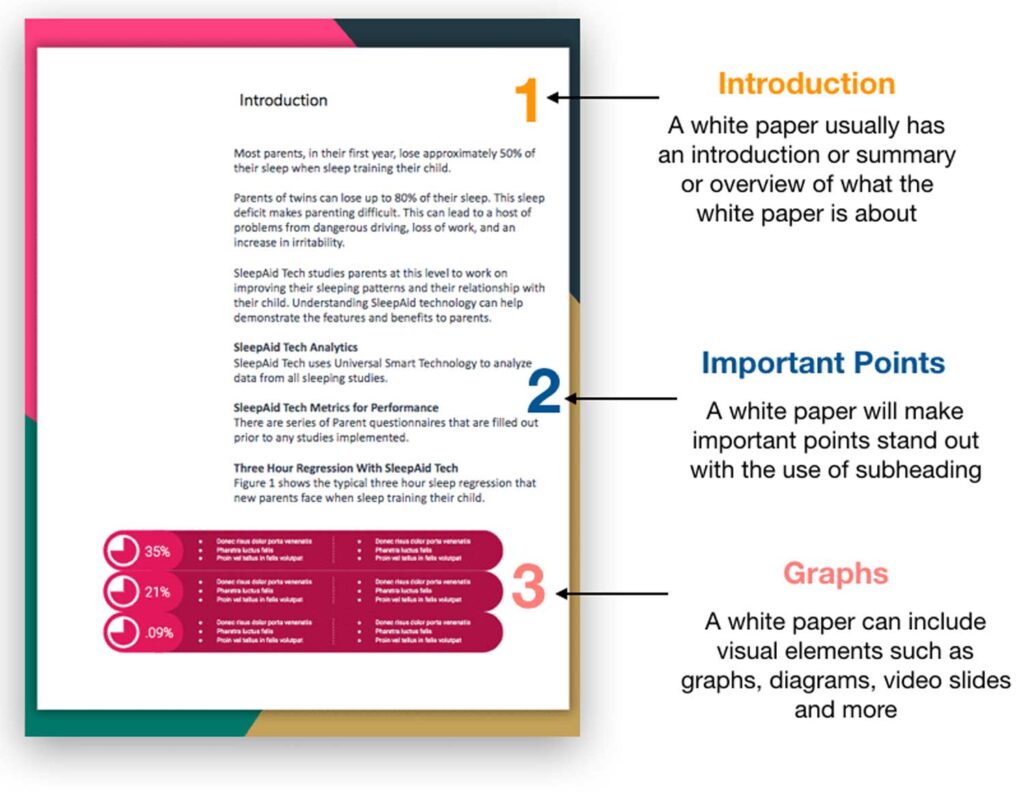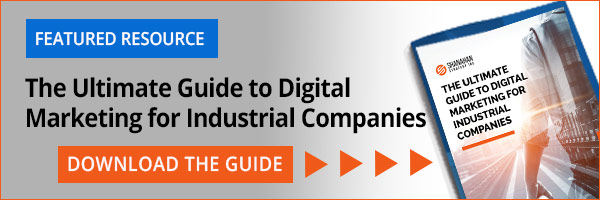Today’s buyers and consumers are more discerning than ever before. Learn how to create whitepapers to sell your product and earn customer trust and loyalty.
With access to so much information on the internet, shoppers are empowered to conduct their own research and find the solutions that meet their unique needs. Today, 93% of shoppers read reviews before buying a product. This indicates that, from price comparisons to understanding features and functionality, consumers want to make fully informed purchase decisions. Whitepapers can provide the facts and figures people need to feel confident in buying your product. As such, they can be a powerful element of brand marketing for manufacturing companies.
Keep reading to learn how to create whitepapers that convert.
Key Takeaways
- Whitepapers are in-depth, educational reports that present useful solutions to specific problems.
- While not sales materials, whitepapers are an important first step in the sales process and can be effective supplements to marketing and sales pieces.
- Among other things, whitepapers help you build your reputation, earn trust and loyalty, and generate more revenue.
- From choosing a relevant topic to avoiding common mistakes, you can easily create impactful whitepapers that convert.
What Exactly are Whitepapers?
Whitepapers are educational reports that present useful solutions to specific problems. They’re objective, long-form documents whose intent is not to sell a product, but to provide expert-level, in-depth data and research. They’re an especially effective element of content marketing for manufacturing companies, where technical information can be confusing and difficult to understand.
An impactful tool for companies who are trying to earn the business of other companies, whitepapers:
- Identify a problem your customers face and its overall impact
- Address unsuccessful approaches and present your solution
- Provide arguments supported by credible statistics and research
Readers access your whitepapers by downloading them from your website after providing their contact information, making them website must-haves for manufacturing companies. While whitepapers don’t focus on selling a product, they can be the first step in your sales process as they help you develop a list of potential customers that you can nurture and convert into customers.
5 Benefits of Whitepapers
A well-written whitepaper can provide numerous benefits for your brand and your bottom line.

1. Build Your Reputation
Creating high-level, well-researched content that delivers creative solutions helps to build your reputation as an expert in your field. In the American manufacturing industry, there are currently 638,583 manufacturing businesses in operation. Whitepapers help set you apart by establishing you as a thought leader. As such, people will seek out your authoritative insight.
2. Gain Trust and Loyalty
Whitepapers serve as a beneficial resource to your audience. As people come to realize your data is reliable and your research is thorough, they’ll begin to trust you more as a company. Over time, this will earn you customer loyalty, which is important because existing customers account for 65% of a company’s business.
3. Earn Confidence
When making a purchase, especially in an industry like manufacturing, shoppers want to be sure they’re making the right choice. Companies have to stick to a budget, and every dollar they spend on products or equipment for their business matters. Whitepapers provide the data and information consumers need to feel confident in making a purchase decision.
4. Drive Traffic
People who read your authoritative whitepapers will want to visit other areas of your website to learn more about your company and the products you offer. They may seek out other whitepapers to see what other insight you can provide. Whitepapers help with driving website traffic for manufacturing companies, which helps to boost visibility of your website and provide more opportunities to convert visitors to customers.
5. Generate Revenue
Whitepapers can help set you apart from the competition and earn the business of shoppers who were looking at other options. These educational documents give you a chance to prove to your readers why your solution is superior and can convince them to become a customer.
How to Create Whitepapers That Convert
Creating an effective whitepaper is more than simply filling a page with statistics and data. Your whitepapers should tell a story and guide readers through the information in a way that helps them understand the benefits of your research.
Follow these steps to create an impactful and beneficial whitepaper that earns you customers.
Step 1: Choose a Relevant Topic
To ensure people take the time to read your whitepaper, it must cover a topic that they want to read about. Ask current customers what they’d like to see. Monitor online chat threads and forums to uncover questions or concerns weighing on the minds of people in your industry. Look for gaps you could fill to gain even more readership. Whatever topic you choose, be sure it:
- Meets your audience’s needs
- Doesn’t surpass your qualifications
- Hasn’t been overly covered already
Your topic is what will attract the attention of your readers, so be sure it’s relevant to them.
Step 2: Identify Your Audience
Consumers appreciate tailored material that speaks to them. Determine who will be reading your whitepapers. Their experience and level of knowledge will help you understand:
- Tone of voice
- Jargon and language
- How specific data needs to be
- Which platforms to write for
All of this information helps you create relevant content that attracts readers and resonates with your audience.
Step 3: Craft a Powerful Intro and Closing
Your introduction should be captivating, intriguing, and compelling to entice people to read the full document. Include a short summary letting people know what they can expect to learn and how the information will benefit them. End the report with a possible mention of useful products and a call-to-action that drives consumers to your website. Your whitepaper doesn’t include a sales pitch, but it can certainly guide readers to more solutions to their problems.
Step 4: Deliver Value
Whitepapers aim to serve as a valuable resource for your audience. Be sure you deliver meaningful information that delivers value, even if readers don’t convert to customers. People are more likely to share a document that benefits the reader, increasing brand awareness, visibility, and reach.
One of the major benefits to whitepapers is the ability to position yourself as an expert in your field. Leave people with a positive impression of your expertise. Delivering value will build trust and eventually earn you loyal customers.
Step 5: Avoid Common Mistakes
To ensure you’re writing whitepapers that convert, avoid common mistakes like:
- Giving a sales pitch: Whitepaper content is all about your audience, not about your revenue.
- Poor design and aesthetic: Nobody wants to read a document that’s pages of text.
- Not enough research: If you want readers to see you as an expert, provide plenty of facts and data to back up your claims.
- Lack of explanation: Explain your findings in detail so readers can have a full understanding of your report.
Focus on addressing your audience’s concerns, present solutions in detail, and create a document that entices people to read and share with their network. This is how to create a whitepaper that will ultimately help you sell your product.
The following video provides some tips to help you get started in creating an effective whitepaper:
Source: Brian Boys on YouTube
Create Effective Whitepapers That Earn Business
Shanahan Strategy follows marketing trends for manufacturing companies to build effective digital marketing strategies that help generate revenue and growth. From identifying SEO basics for manufacturing and industrial companies to creating successful campaigns for marketing for manufacturing, Shanahan Strategy can help you reach your goals.
Contact Shanahan Strategy today to learn how we can help you create effective whitepapers that earn you business.


